Casualties were extremely heavy nearly 7,000 Americans killed and close to triple that number wounded.
In todays article, Capt.
Dale A. Dye, U.S.M.C.
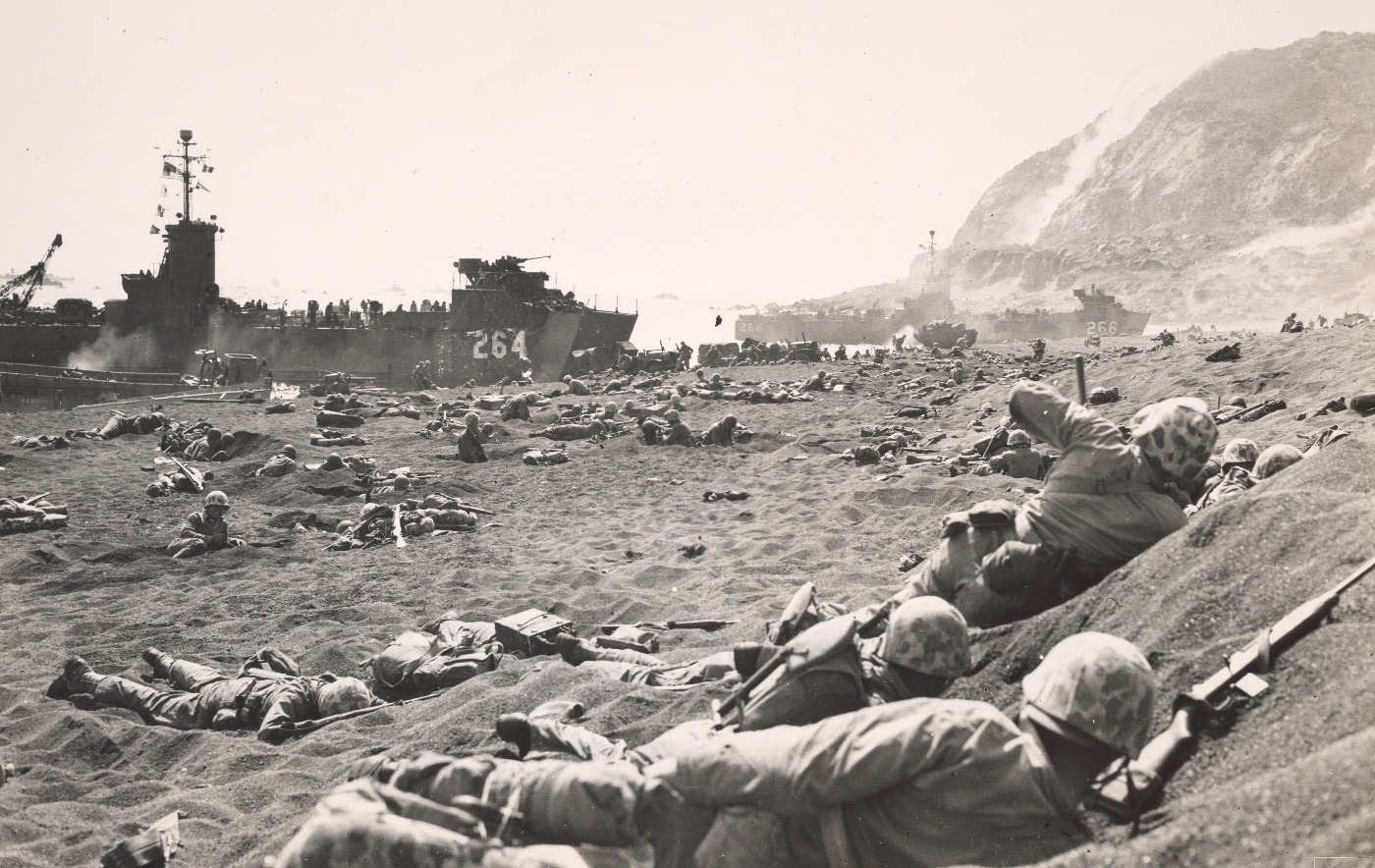
Marines try to find cover in the volcanic sand on the Iwo Jima beach. A heavy rain of enemy fire comes from enemy positions on Mount Suribachi in the background. Image: U.S. Marine Corps
describes his experiences in visiting that historic volcanic island.
Devout Muslims make the trek to Mecca.
Devout Marines if theyre lucky enough make a soul-stirring journey to Iwo Jima.
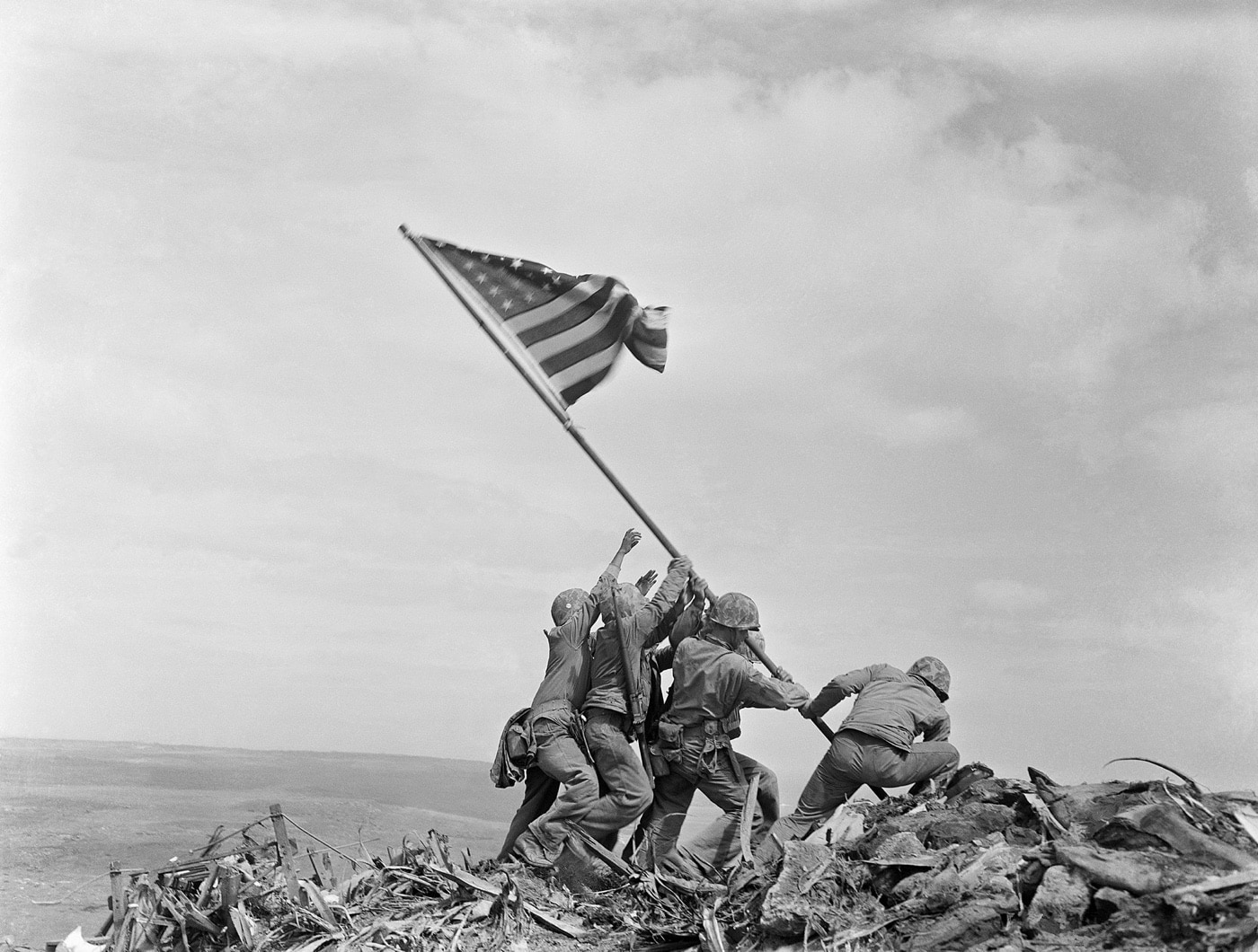
U.S. Marines raise the flag on Mount Suribachi during the Battle of Iwo Jima. Image: Joe Rosenthal/A.P. (Public Domain)
[Check out Tom Laemleins article onWW2 American flamethrowers.]
Mount Suribachi is the highest point on the island at 554 feet above sea level.
Allied planners realized all this.
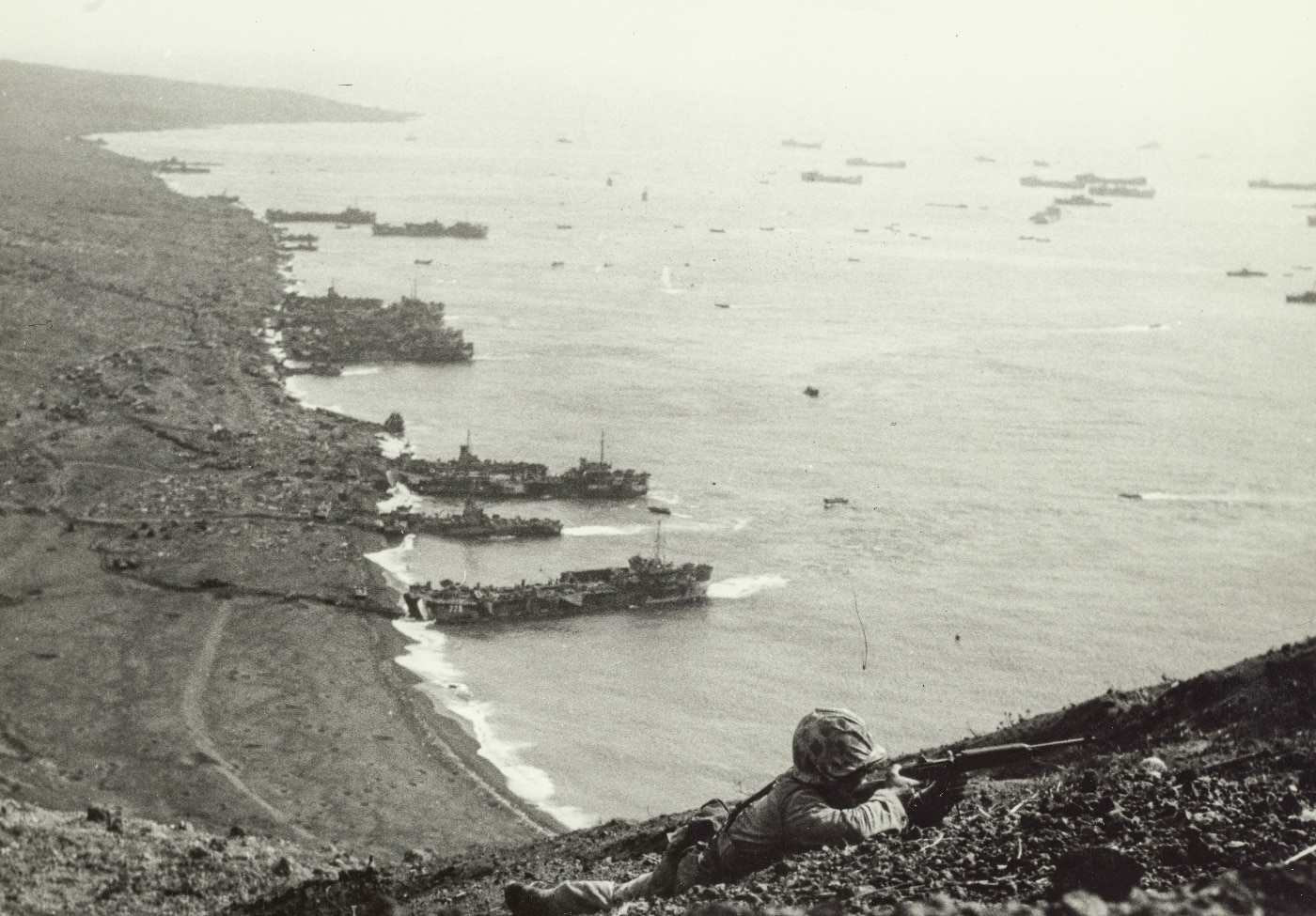
A lone Marine covers the flank of a patrol making its way up Mount Suribachi. From this vantage point, the enemy had a clear view of the Marines landing on Iwo Jima. Image: Lou Lowery/U.S. Marine Corps
So did the Japanese.
Iwo Jima was considered a part of Tokyo Prefecture.
Ichimaru controlled two large fighter units, a construction battalion and a bunch of coastal defense and AA units.
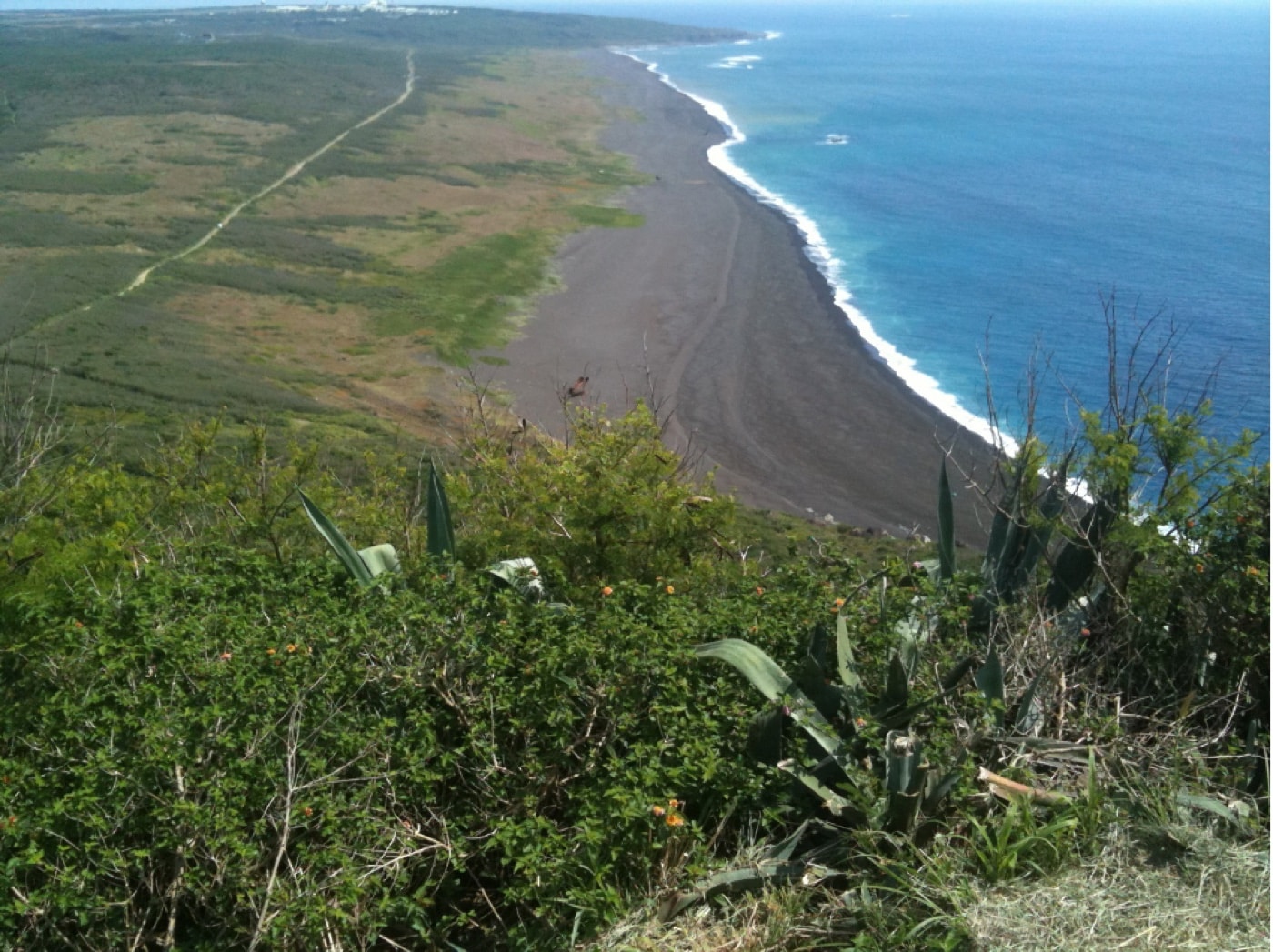
A modern view of the Iwo Jima landing beaches from Mt. Suribachi. From frame lower right to center left: Beaches Green and Red (5thMarDiv) and then Yellow and Blue (4thMarDiv). Image: Dale A. Dye
It all amounted to around 20,000 Japanese defenders on the island.
They went to work with tenacious defense as a single-minded purpose.
All over Iwos eight square miles of volcanic ash, Japanese forces found, cleared and reinforced natural caves.
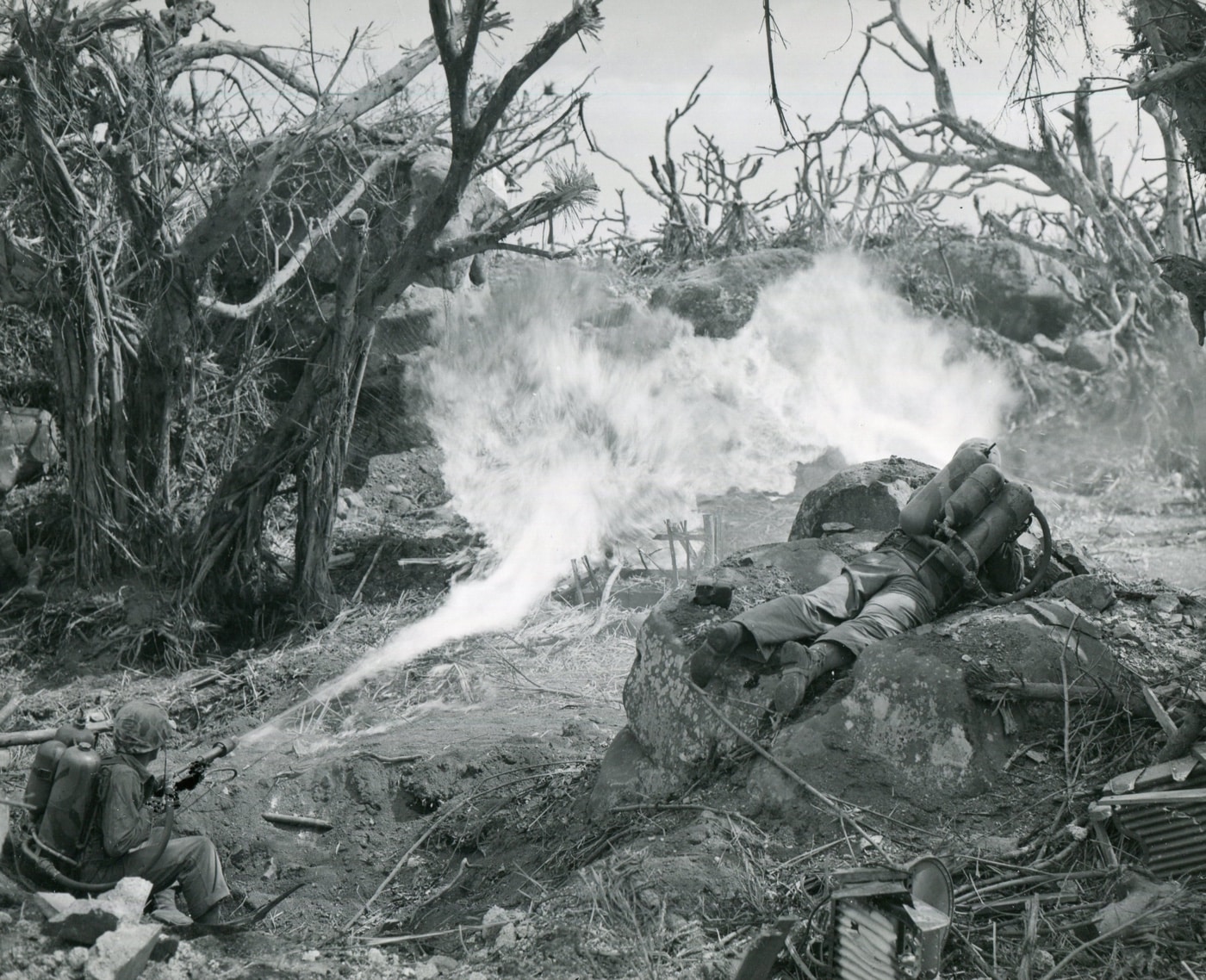
Two Marines hit the deck to throw a scorching inferno at reinforced Japanese defenses that blocked the way to Iwo Jima’s Mount Suribachi. Image: NARA
They dug in like termites all over Mt.
Suribachi at the islands southern tip where the high ground dominated both of the islands possible landing beaches.
Every inch of those beaches was zeroed in for enfilading fire.
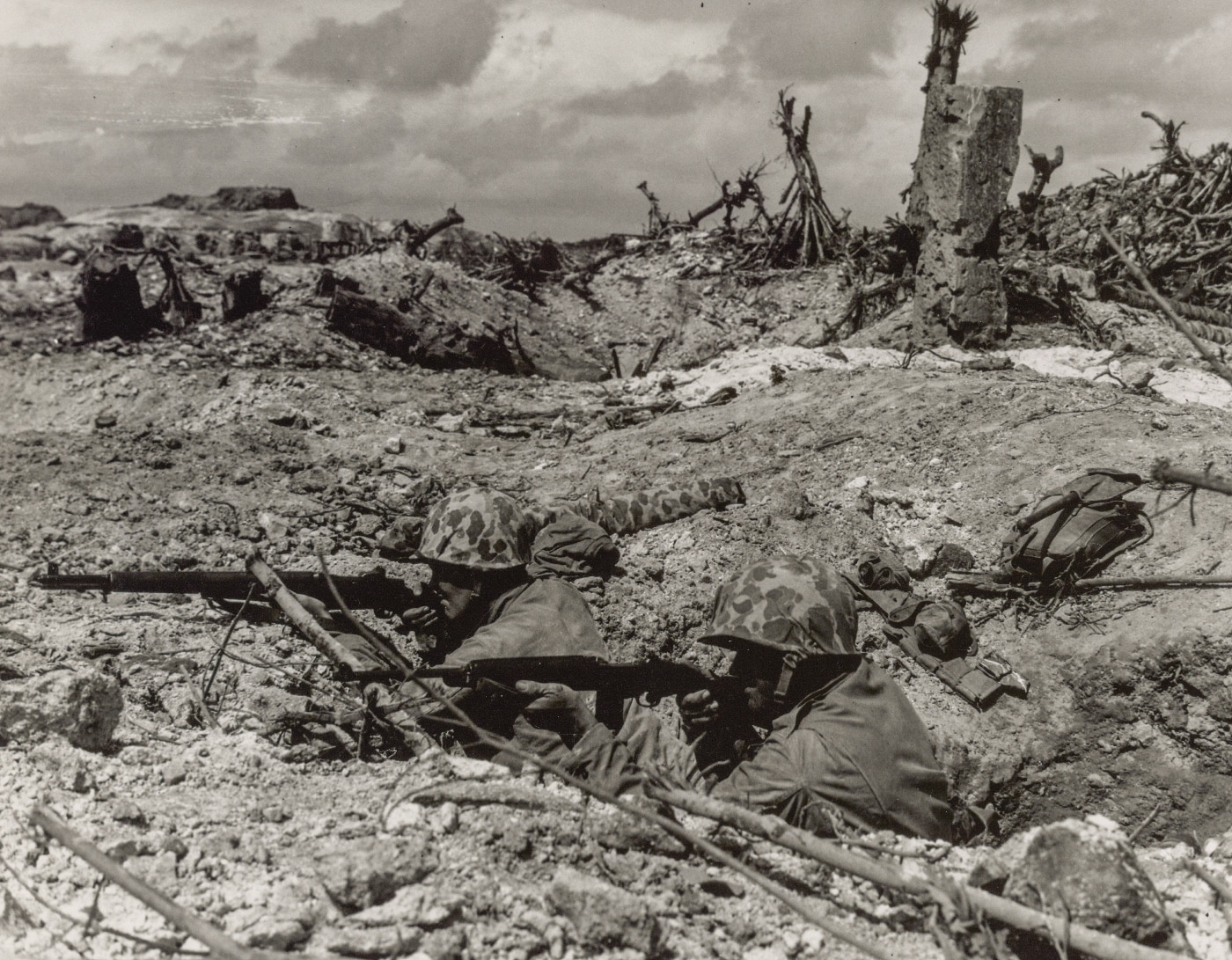
Two Marines in a hole hastily dug from smoking sulphur rock stand ready to repel a Jananese counterattack on Iwo Jima. Image: Sgt. Bob Cooke/U.S. Marine Corps
Blockhouses and pillboxes flanked the landing areas.
Machine guns were sighted for deadly interlocking fire.
Rockets, anti-boat and anti-tank guns were emplaced with wide-open fields of fire.
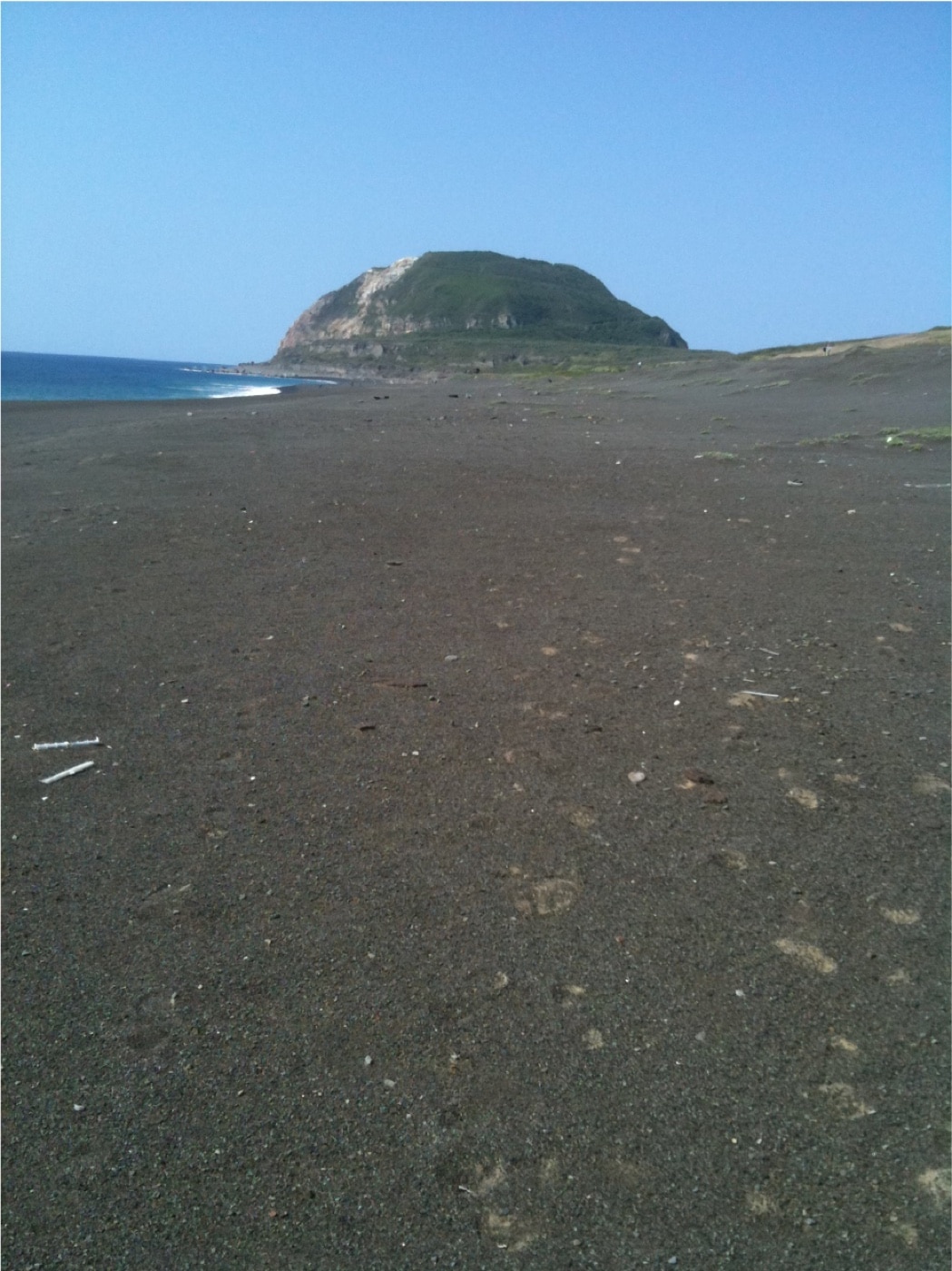
A view across the beach toward Mt. Suribachi. Plunging fire from this high position took a heavy toll on Marines attempting to push inland from all of the landing beaches. Image: Dale A. Dye
When the calendar flipped to 1945, the Japanese were ready.
The first thing I noticed was the smell.
Theres an obvious and odious miasma that hangs over Iwo Jima.
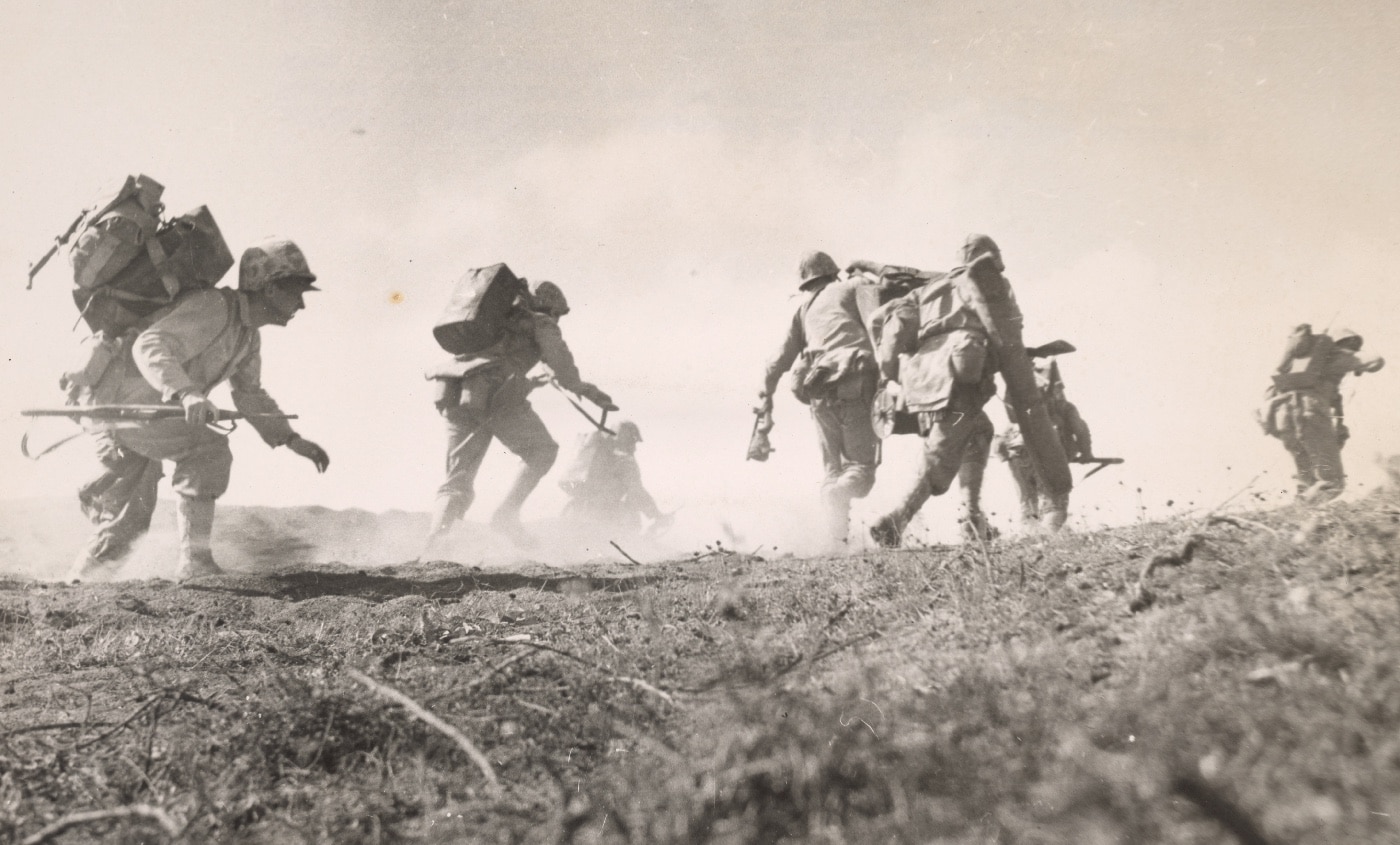
Burdened with heavy packs and equipment, Marine communicators dash for cover during the inland drive from the Iwo beachhead. Image: Warrant Officer Obie Newcomb/U.S. Marine Corps
Its no wonder Marines and others called it sulfur island.
The place reeks of that element and reminds constantly that youre walking around on a dormant volcano.
And I thought about a lesser-known photographer who also captured that drama.
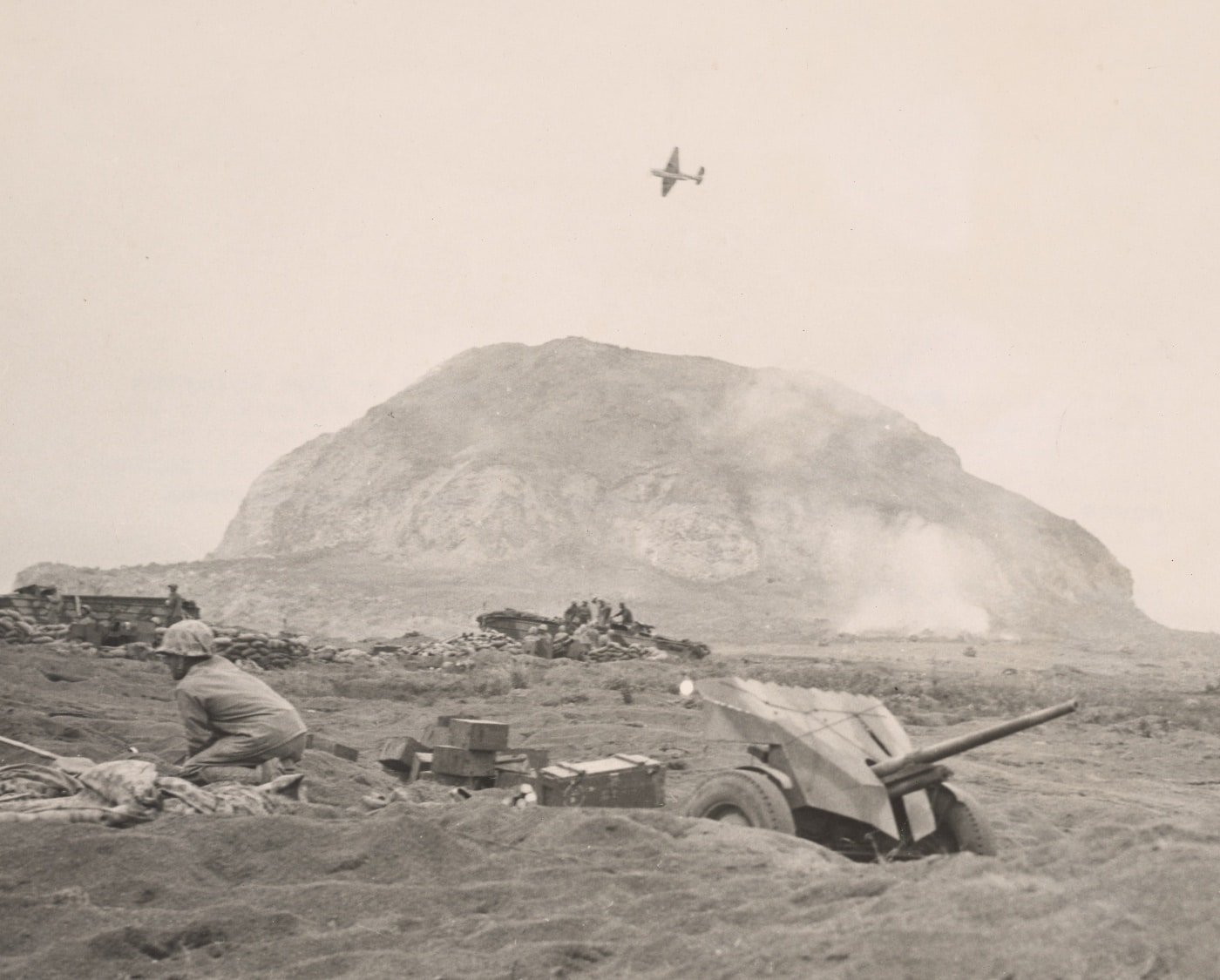
Marines at Motoyama Airfield No. 1 are dwarfed by Mt. Suribachi. The highest point on the island was defended by the Japanese using honeycombed caves. Image: Pfc. Jack Campbell/U.S. Marine Corps
Marine Sergeant Bill Genaust shot 16mm color film of the flag-raising.
Genaust was killed on Iwo and his body never recovered.
That left the assaulting Marines with just one tactic frontal assault.
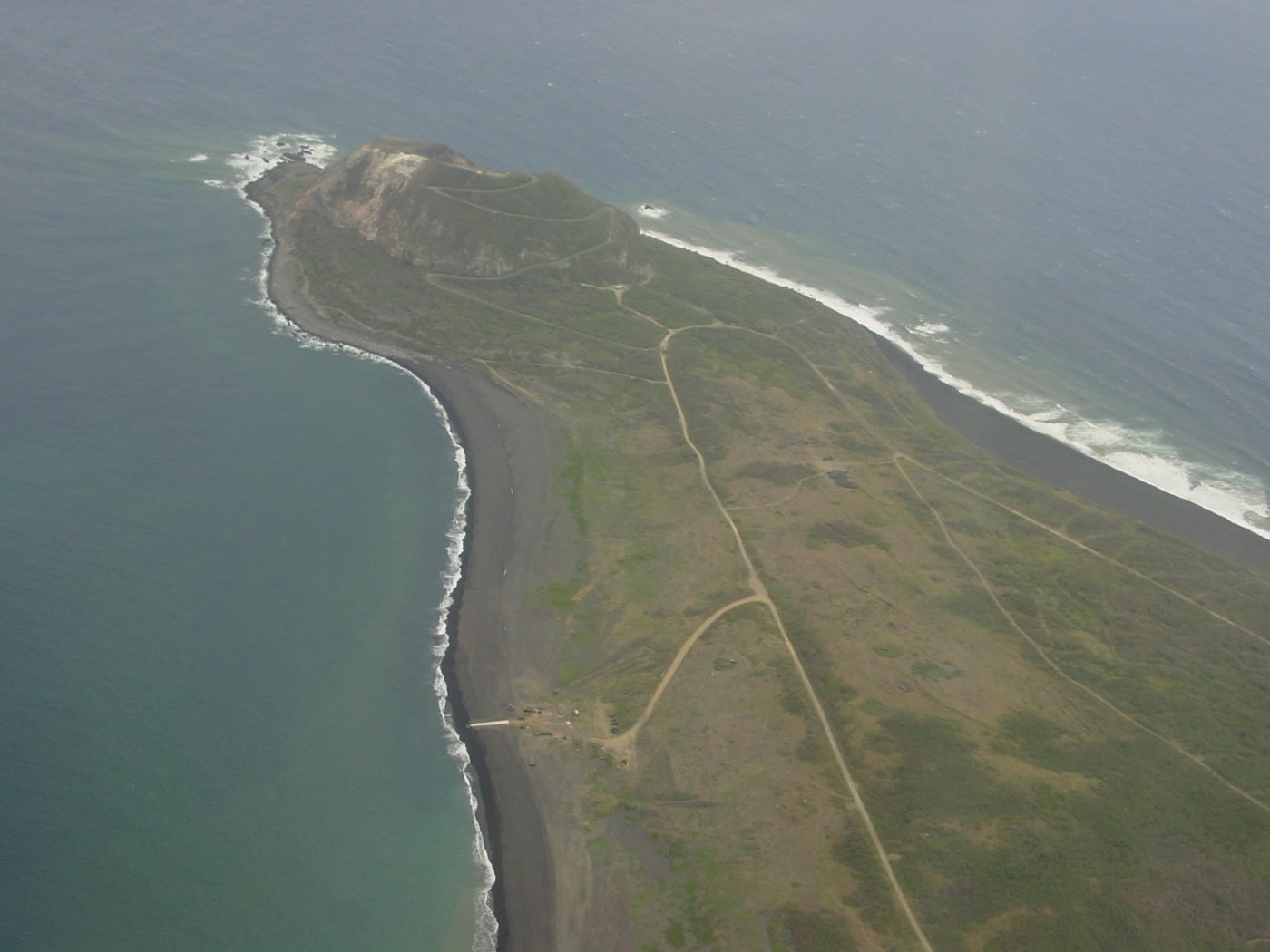
Approaching Iwo Jima from the north for a landing at what was once Motoyama Airfield No. 1. Mount Suribachi is the high ground at the top (south) end of the eight-square-mile island. Image: Dale A. Dye
One step up and three steps back just to reach the beach plateau.
February 19 was just the first of 36 bloody days it took to secure Iwo Jima.
As much as possible, those were the sites I wanted to explore.
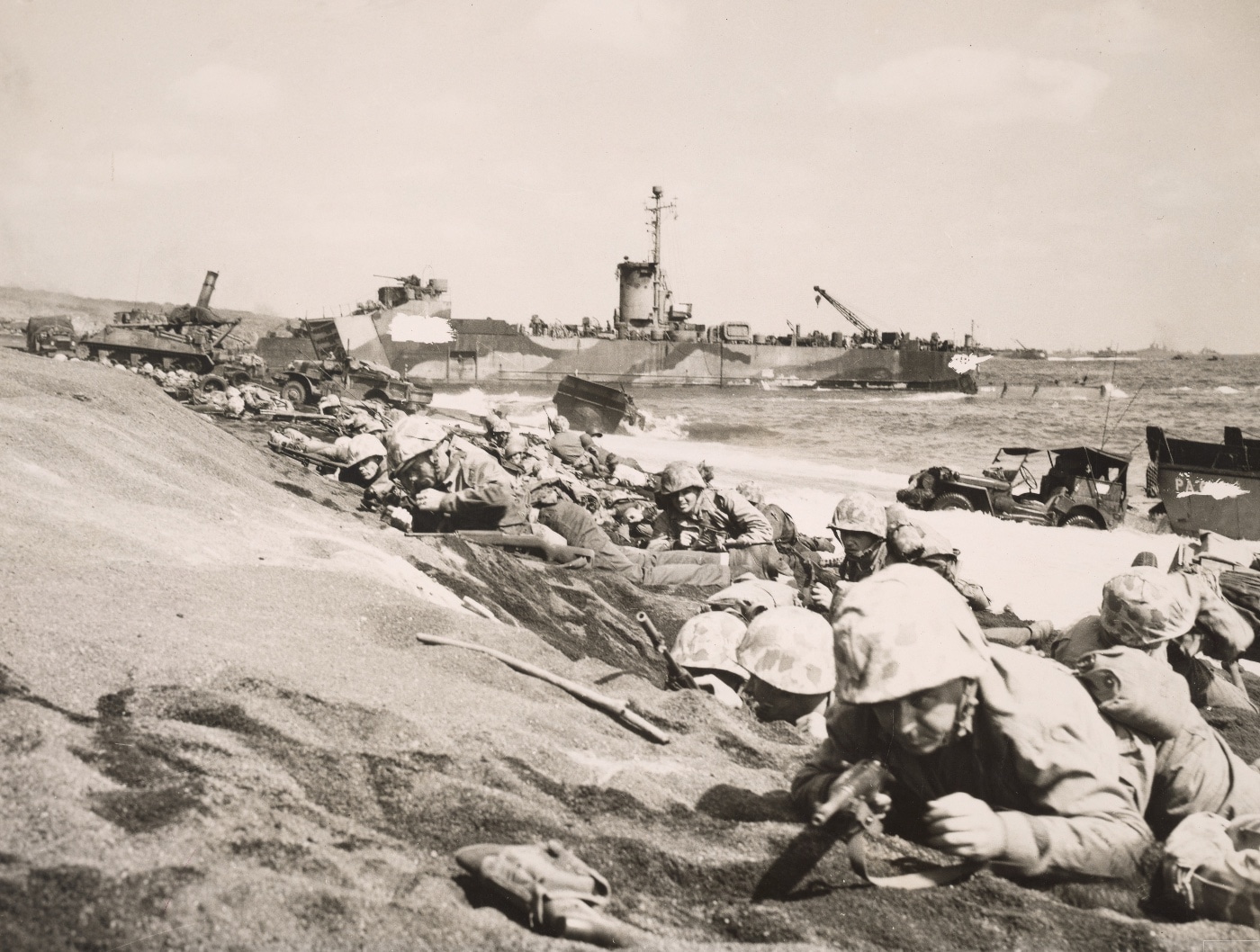
Fourth Marine Division Marines are briefly pinned down by enemy fire as they hit the beach at Iwo Jima on D-Day. Image: Tech Sgt. H. Neil Gillespie/U.S. Marine Corps
Quasi-official visitors like me were pretty much left on their own to explore.
And a military history nerd like me knew where to do that.
Apparently, Admiral Ichimaru had some of his own Marines on the island to face their American counterparts.

Determination written on their faces, Marines start the drive to the interior of Iwo Jima. Image: Warrant Officer Newcomb/U.S. Marine Corps
There were many caves too thoroughly blasted or threatening to collapse, which limited exploration.
It had been hard hit during the fighting in 1945.
And the deeper you got, the hotter it was.
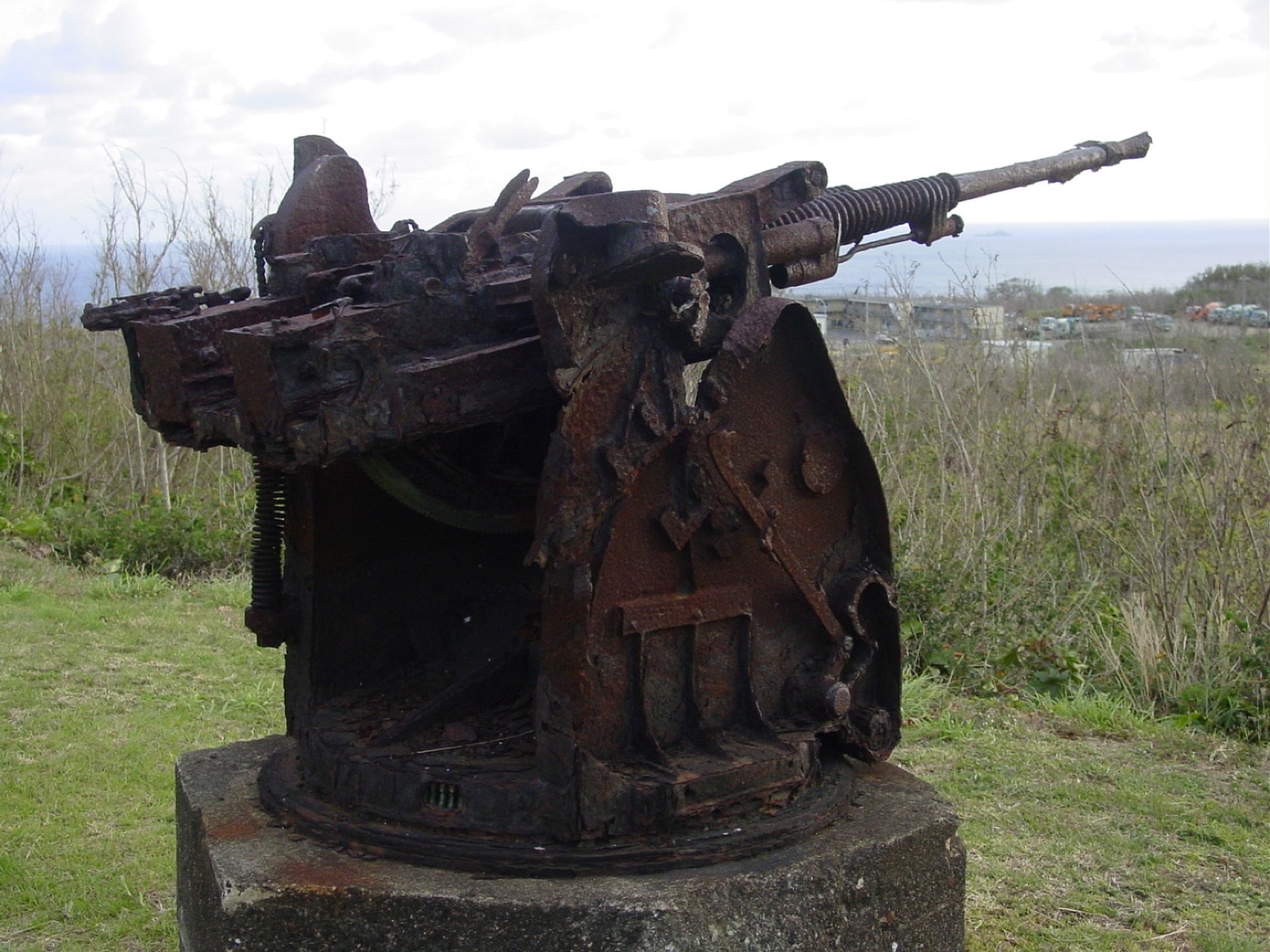
Remains of a Type 96 25mm anti-aircraft/anti-tank cannon emplaced near Motoyama Airfield No. 1. It is a Japanese variant of the French Hotchkiss 25mm AA gun. Image: Dale A. Dye
Never mind the shells, bombs and rockets, just breathing in that cave complex was a chore.
Probably where the General received field reports and studied his maps.
The U.S. Navy lost almost 900 sailors with another 1,900+ wounded.
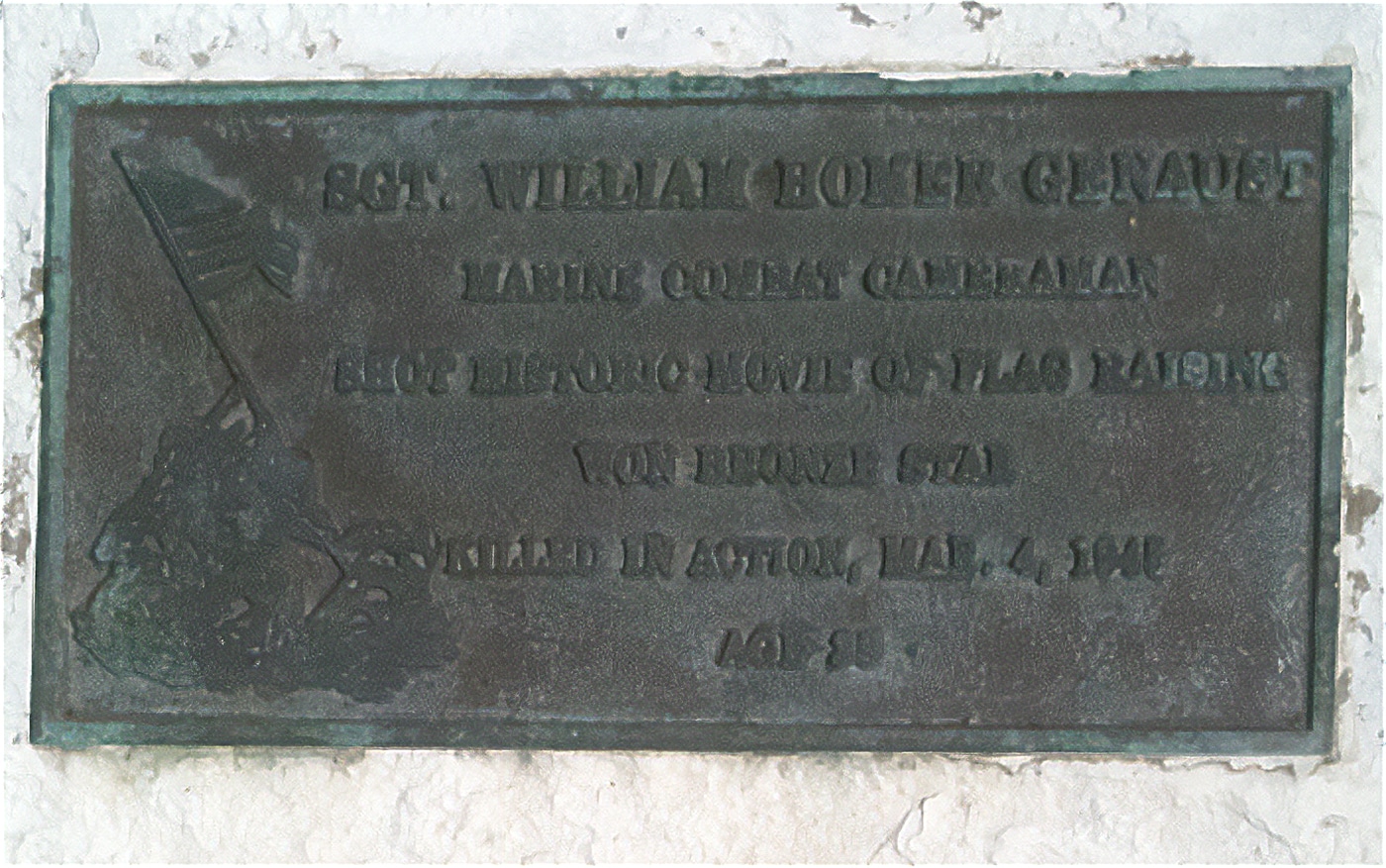
A monument to one of the battle’s unsung heroes: Sgt. Bill Genaust. A Marine Combat Photographer, he shot 16mm color film of the flag-raising on Mt. Suribachi. Sgt. Genaust was KIA. Image: Dale A. Dye
The escort carrier USSBismarck Sea(CVE-95) sunk after being hit by five bomb and kamikaze attacks.
The carriers USSSaratoga(CV-3) and USSLunga Point(CVE-94) were also damaged by kamikaze attacks.
In total, 18 U.S. ships and gunboats were damaged or sunk during the invasion.

Marines blast Japanese positions near the base of Mt. Suribachi on Iwo Jima. Image: Pvt. Campbell/U.S. Marine Corps
Japanese defenders lost nearly everyone involved in the battle.
Barely a thousand of 20,000 original defenders survived.
Most committed suicide or eventually crawled out to surrender after a few weeks of starvation.
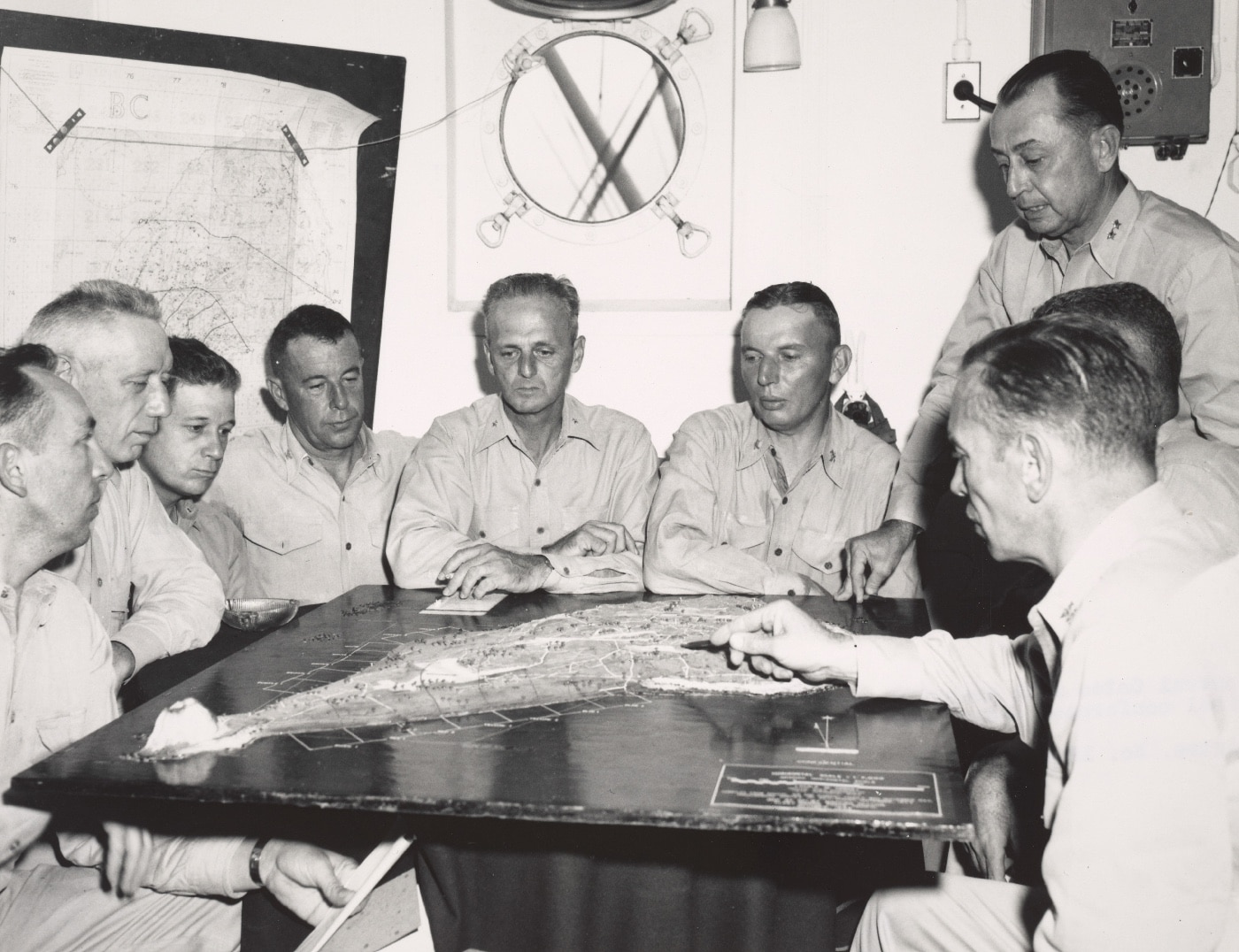
Maj. Gen. Clifton Cates with his executive staff and regiment commanders in a final conference aboard ship before the Iwo Jima landings started. Image: U.S. Marine Corps
And some of them held out by raiding Allied positions at night for water and provisions.
It was a different trip in a lot of ways.
No cave-crawling allowed these days, and the Japanese Self Defense Forces have beefed up their presence significantly.
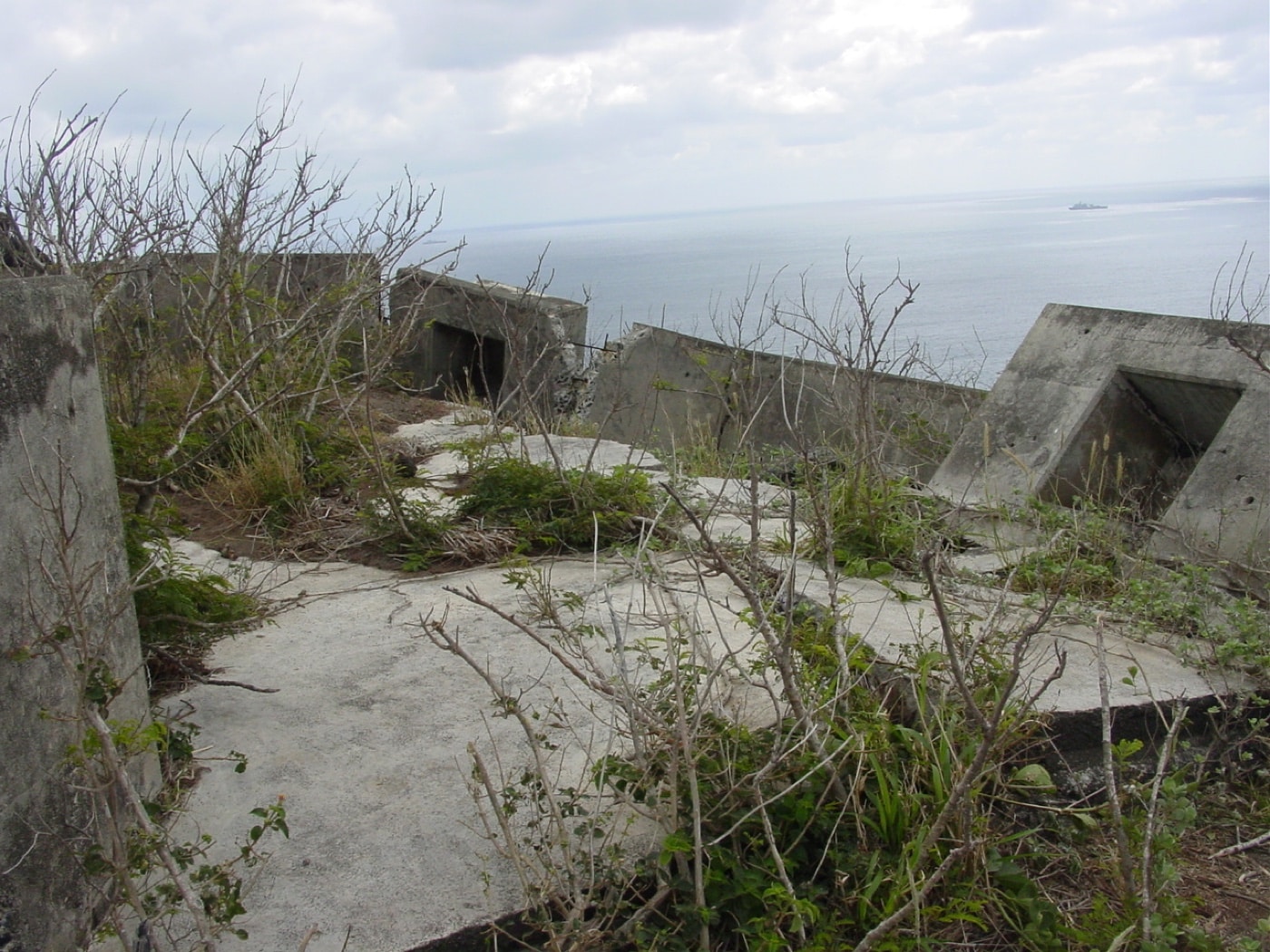
A cluster of defensive bunkers atop Hill 362-B, a strong point near a site known as Bloody Gorge. It was one of the last and most ferocious set-piece battles on Iwo Jima. Image: Dale A. Dye
Battlefield exploration, souvenir hunting and cave crawling are strictly forbidden.
Fleet Admiral Chester Nimitz had it right.
Among those who served on Iwo Jima, uncommon valor was a common virtue.
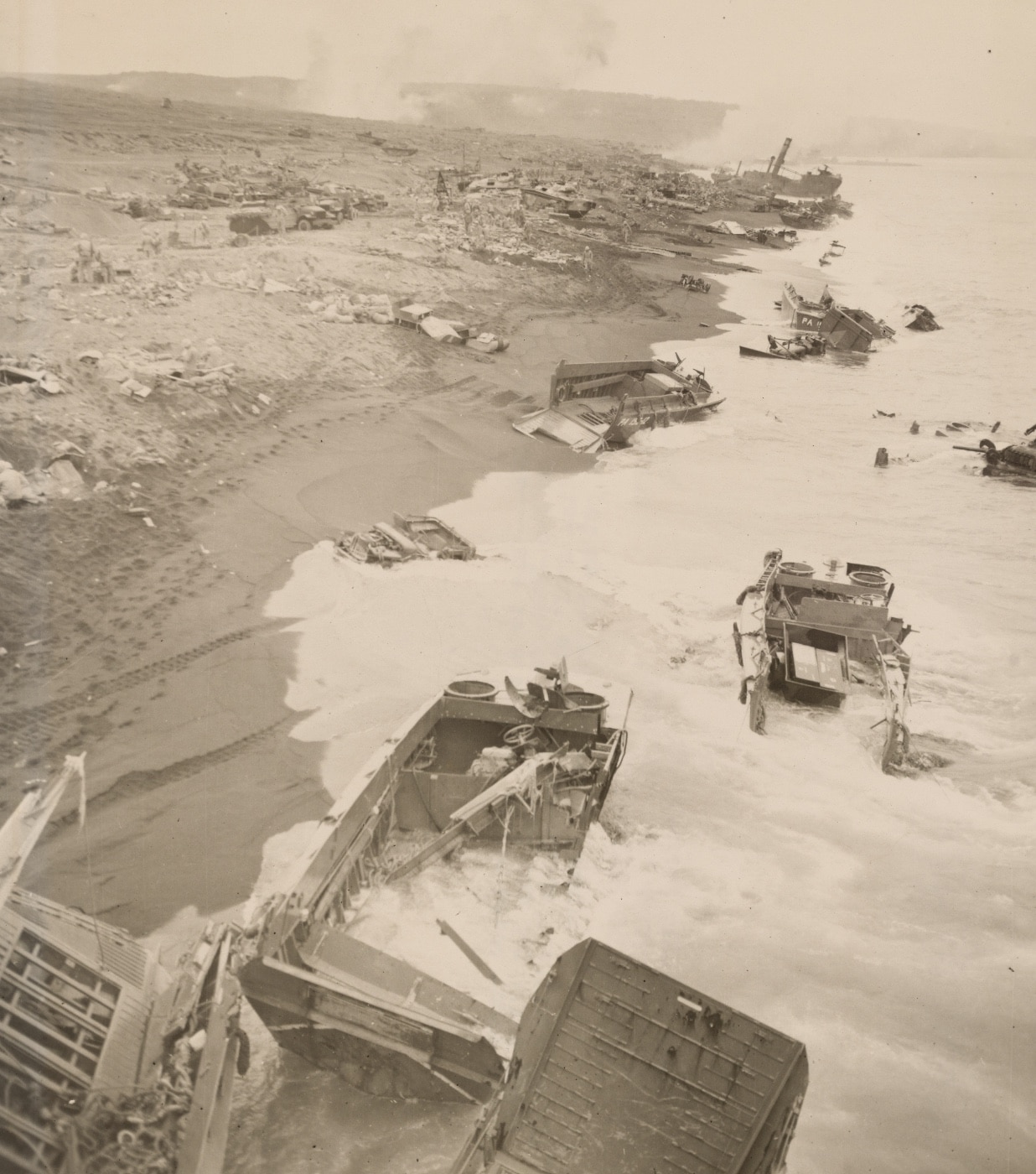
The wreckage of landing craft along the shoreline on the second day of the battle testifies to the stiff opposition put up by the defending Japanese. Image: Cpl. Eugene Jones/U.S. Marine Corps
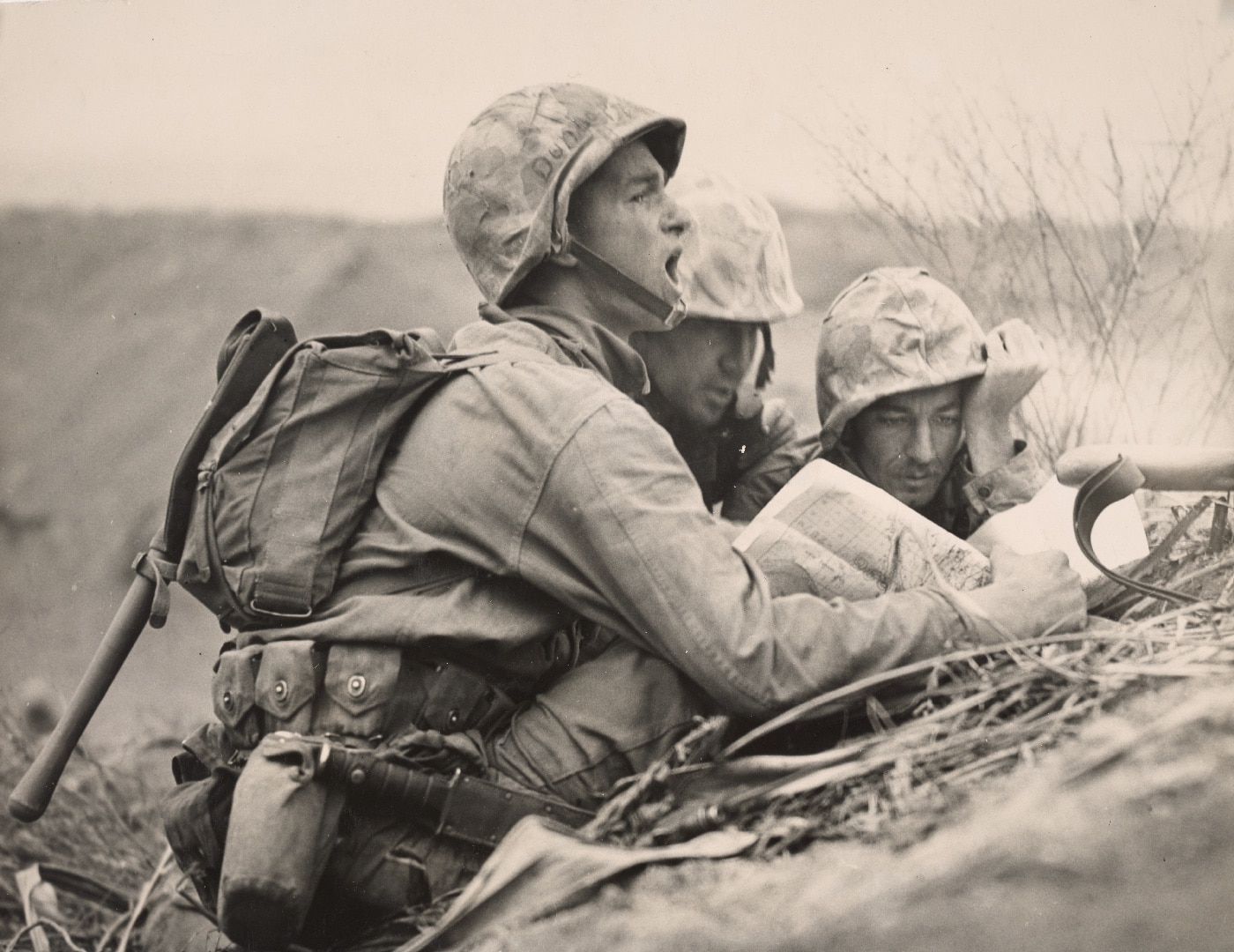
Marine spotters in a forward OP located an enemy machine gun nest and call in artillery and mortar fire. Image: Cpl. John T. Dreyfuss/U.S. Marine Corps
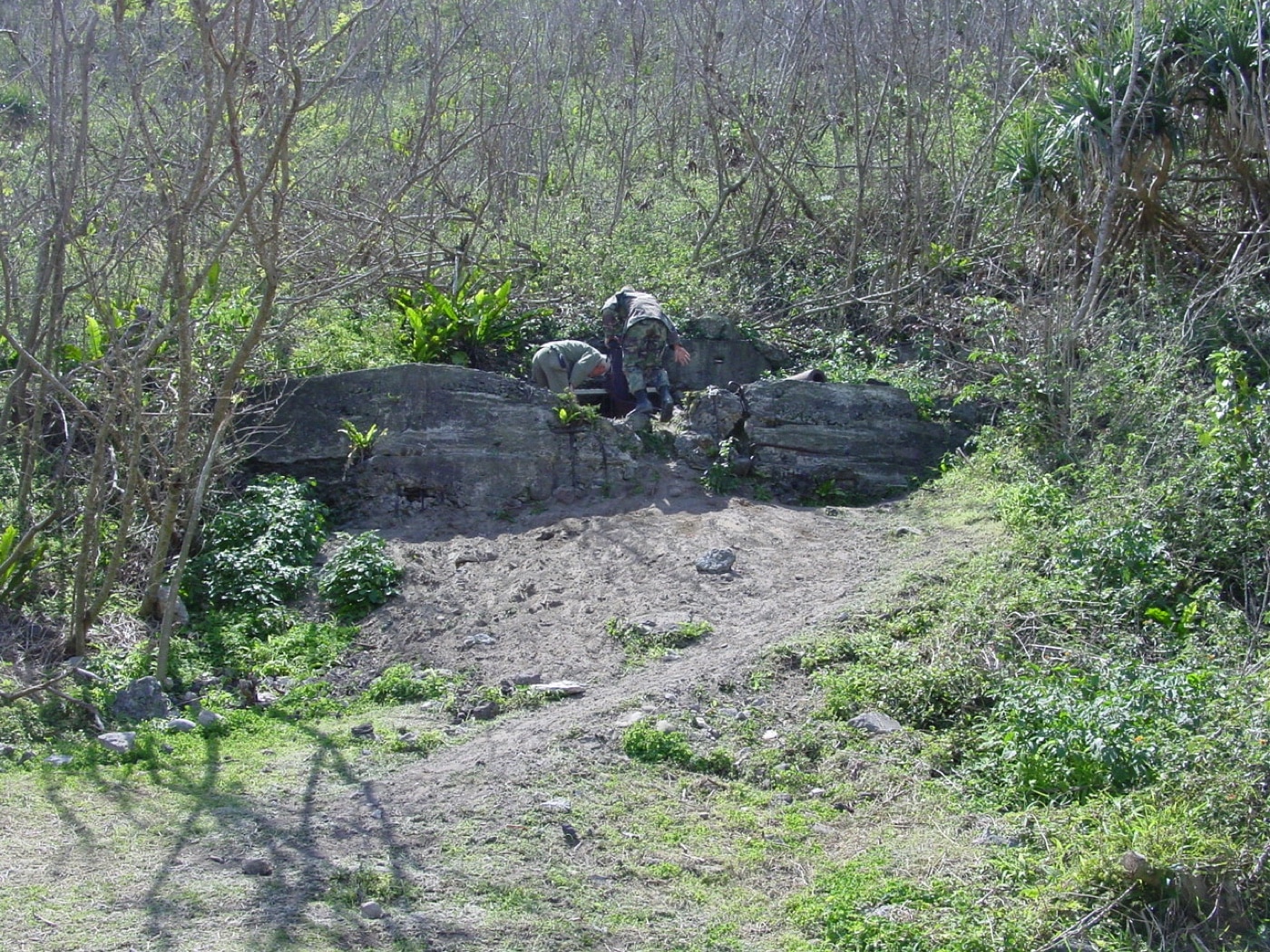
A typical bunker guarding the area of Motoyama Airfield No. 3, which was still being built by Japanese naval construction workers when Marines assaulted Iwo Jima in February 1945. Image: Dale A. Dye
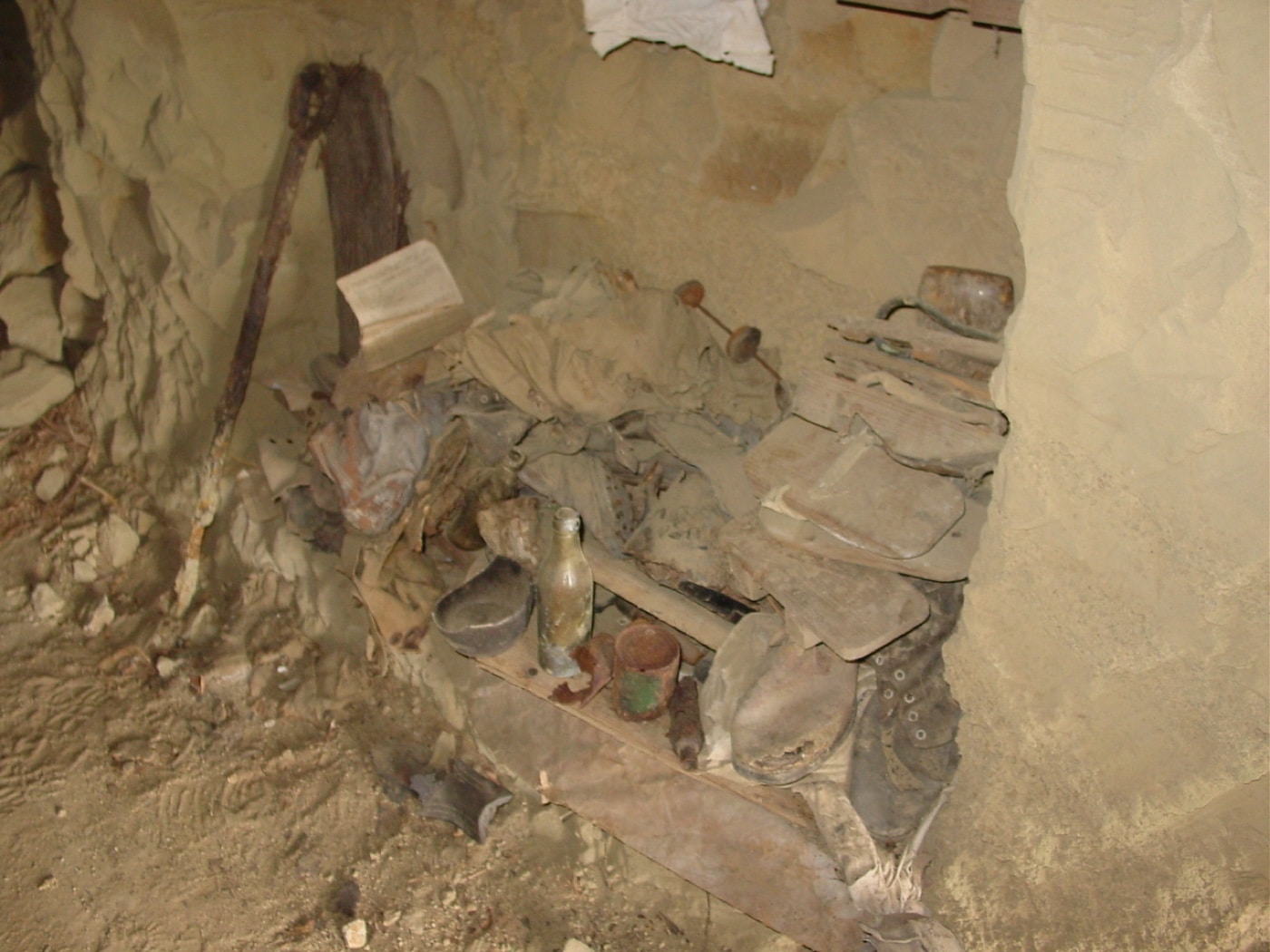
Artifacts remained in the Iwo Jima underground bunker complex believed to be the final command post of Japanese General Kuribayashi. The heat this far under the surface was intense. Image: Dale A. Dye
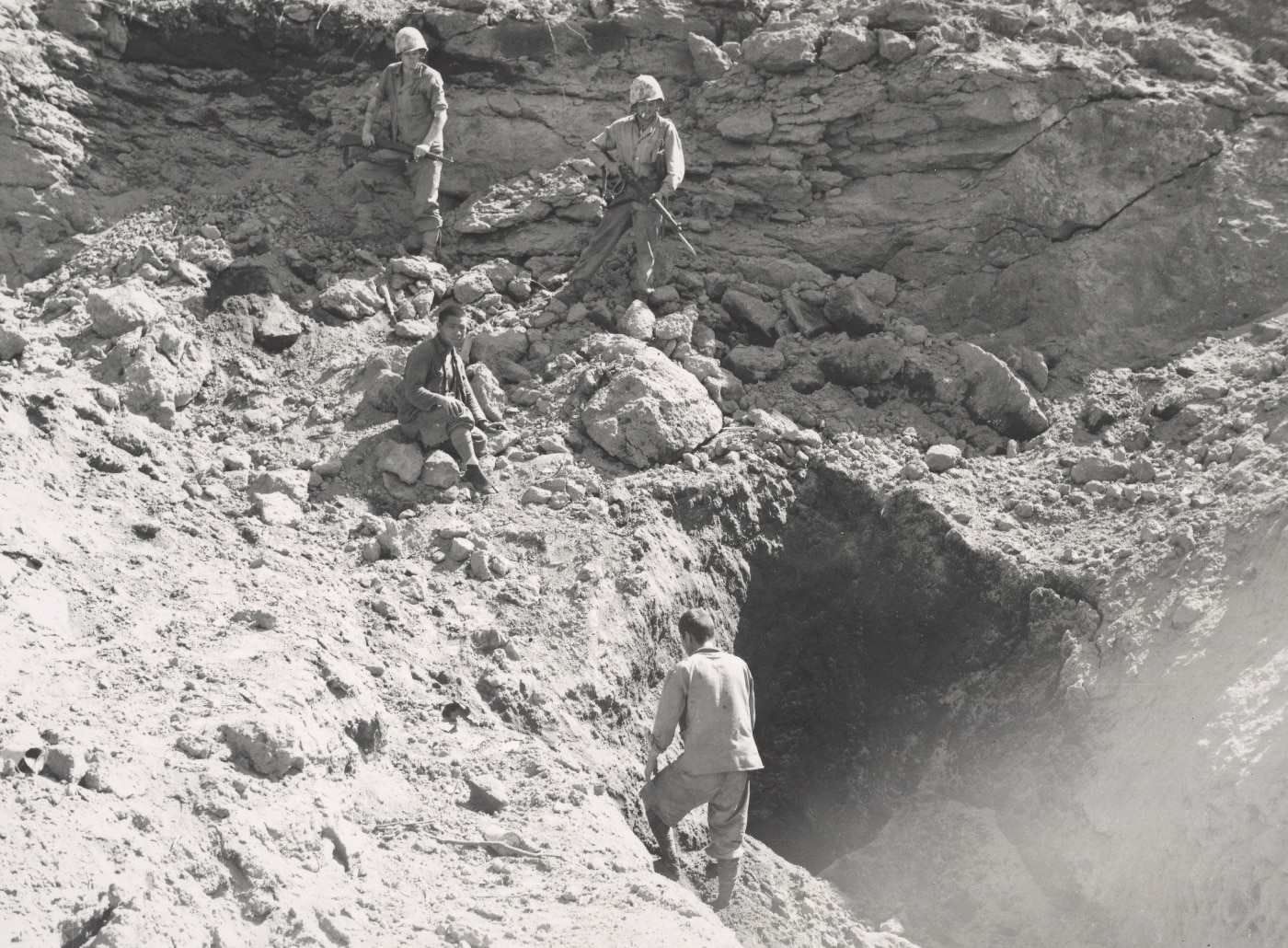
A Japanese POW (middle) tries to talk other Japanese soldiers out of caves. Image: U.S. Marine Corps
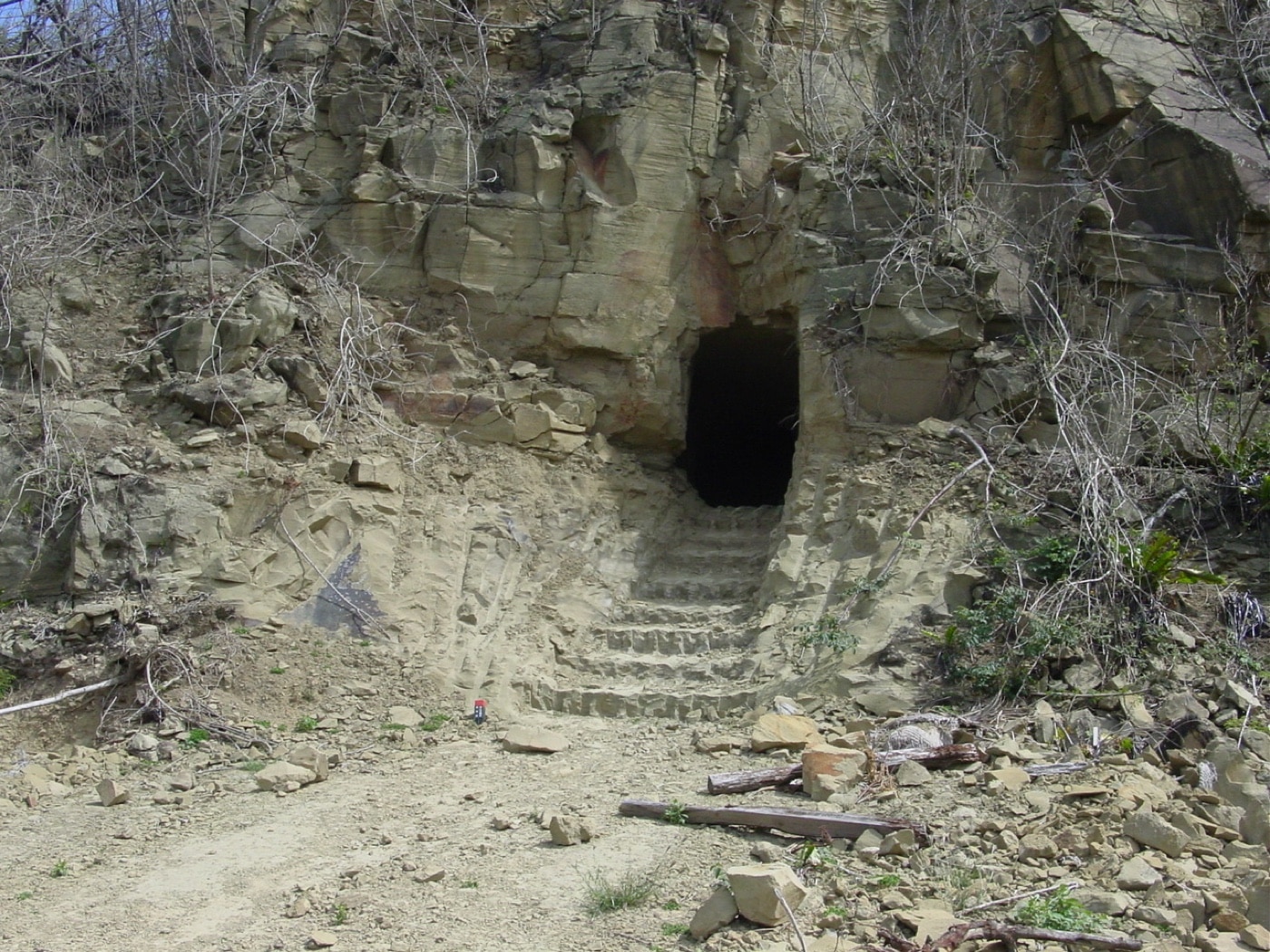
The entrance to what is believed to be one of General Kuribayashi’s command posts on Iwo Jima. This one is extensive and winds deep into Iwo Jima’s sweltering interior. Image: Dale A. Dye
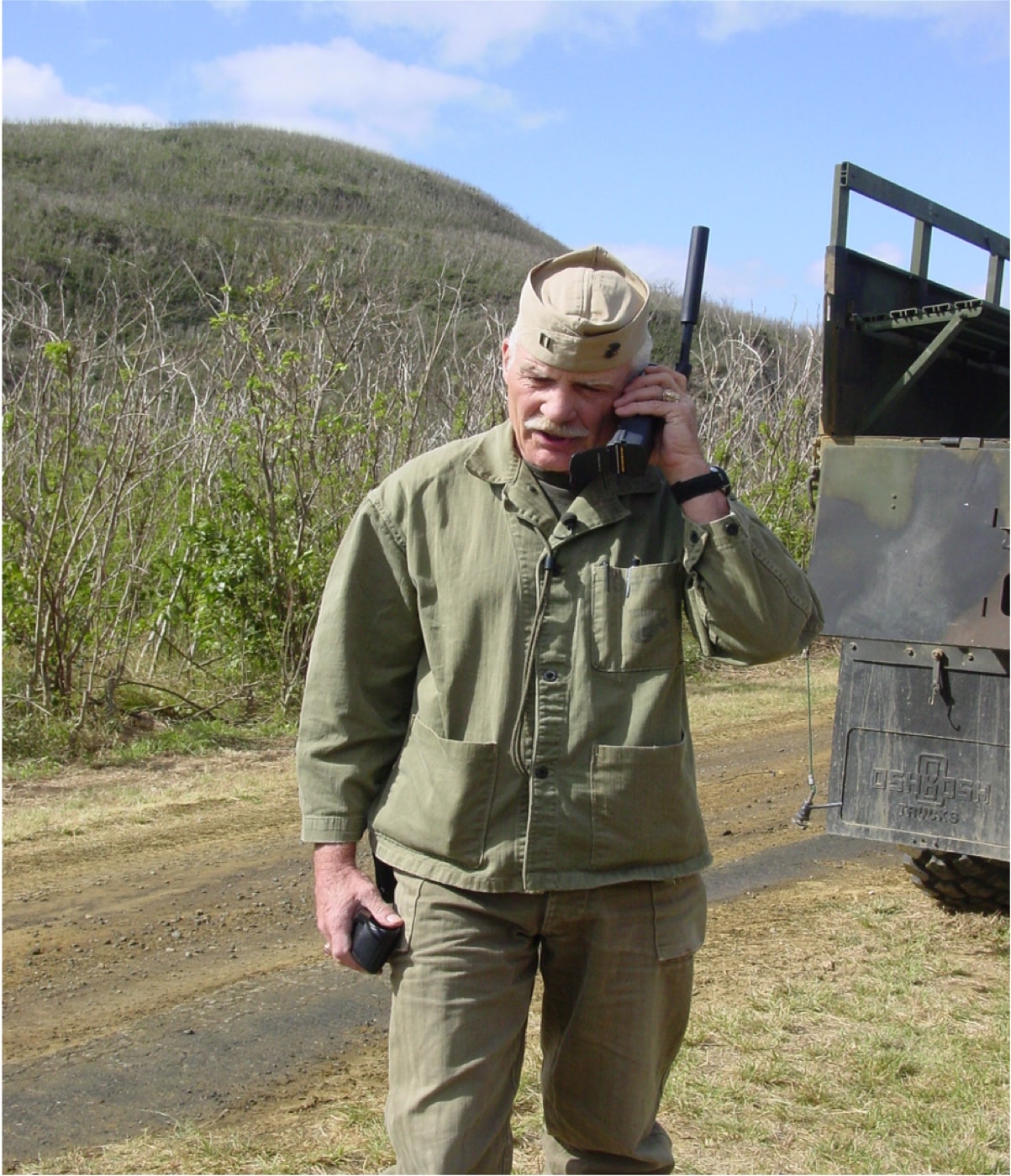
Forget cell phones on Iwo. The only way I had to report to my sponsors during the Reunion of Honor event in 2003 was a satellite phone. Image: Dale A. Dye
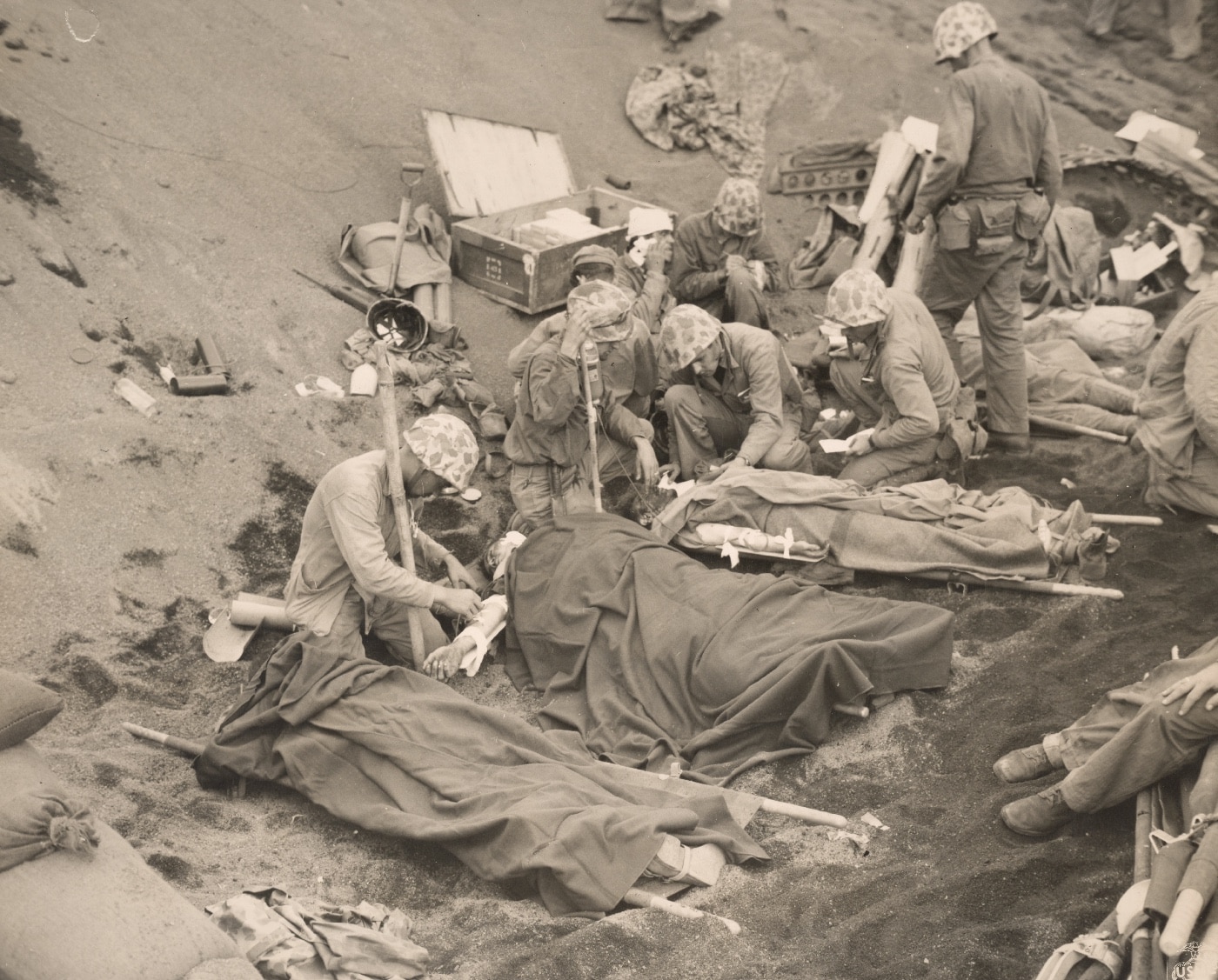
Navy corpsmenadminister to wounded Marines at an aid station established in a gully on Iwo Jima. Image: Warrant Officer Obie Newcomb/U.S. Marine Corps
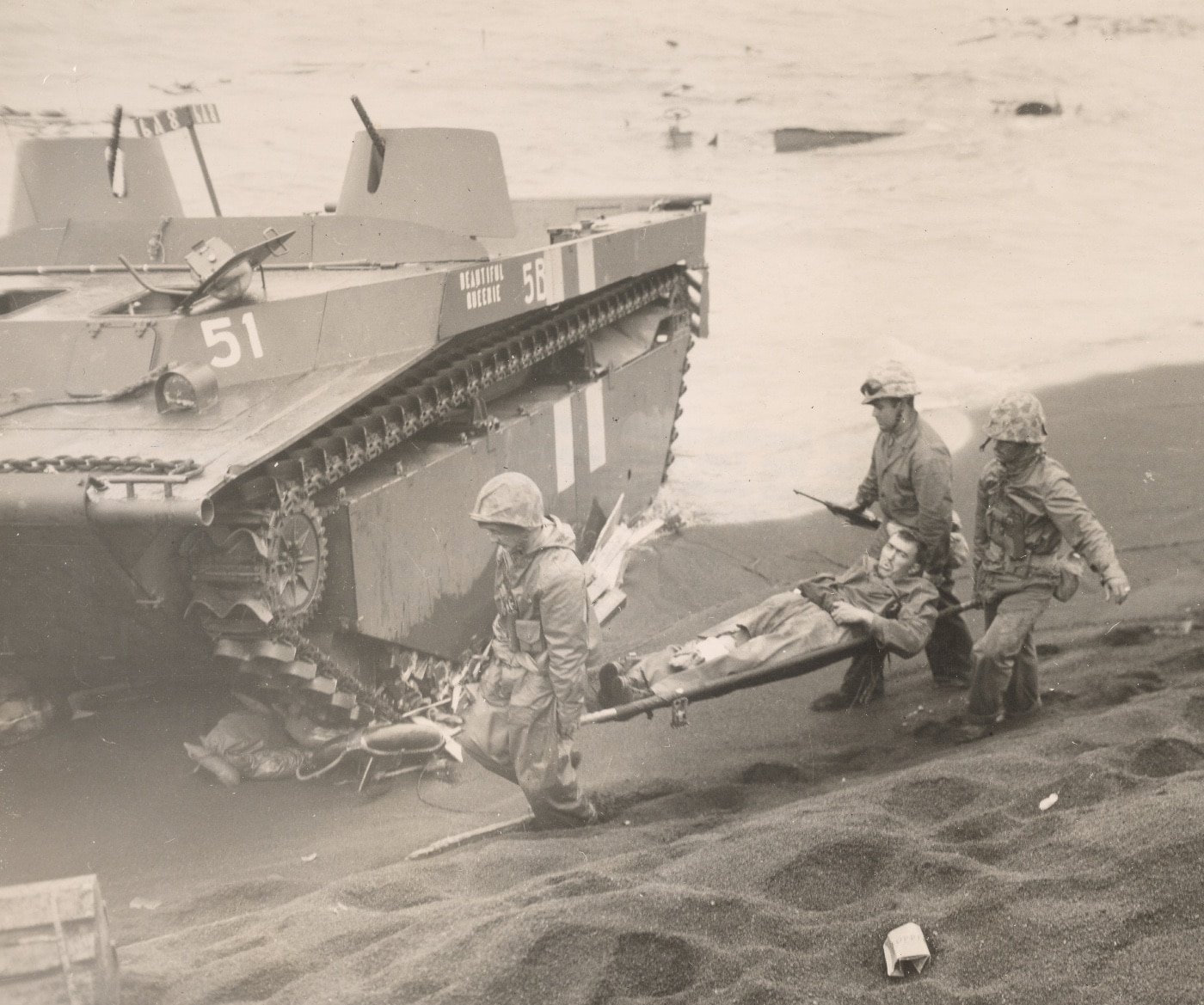
Three Leathernecks carry a wounded comrade to an evacuation point on the Iwo Jima beachhead. Image: Cpl. Eugene Jones/U.S. Marine Corps
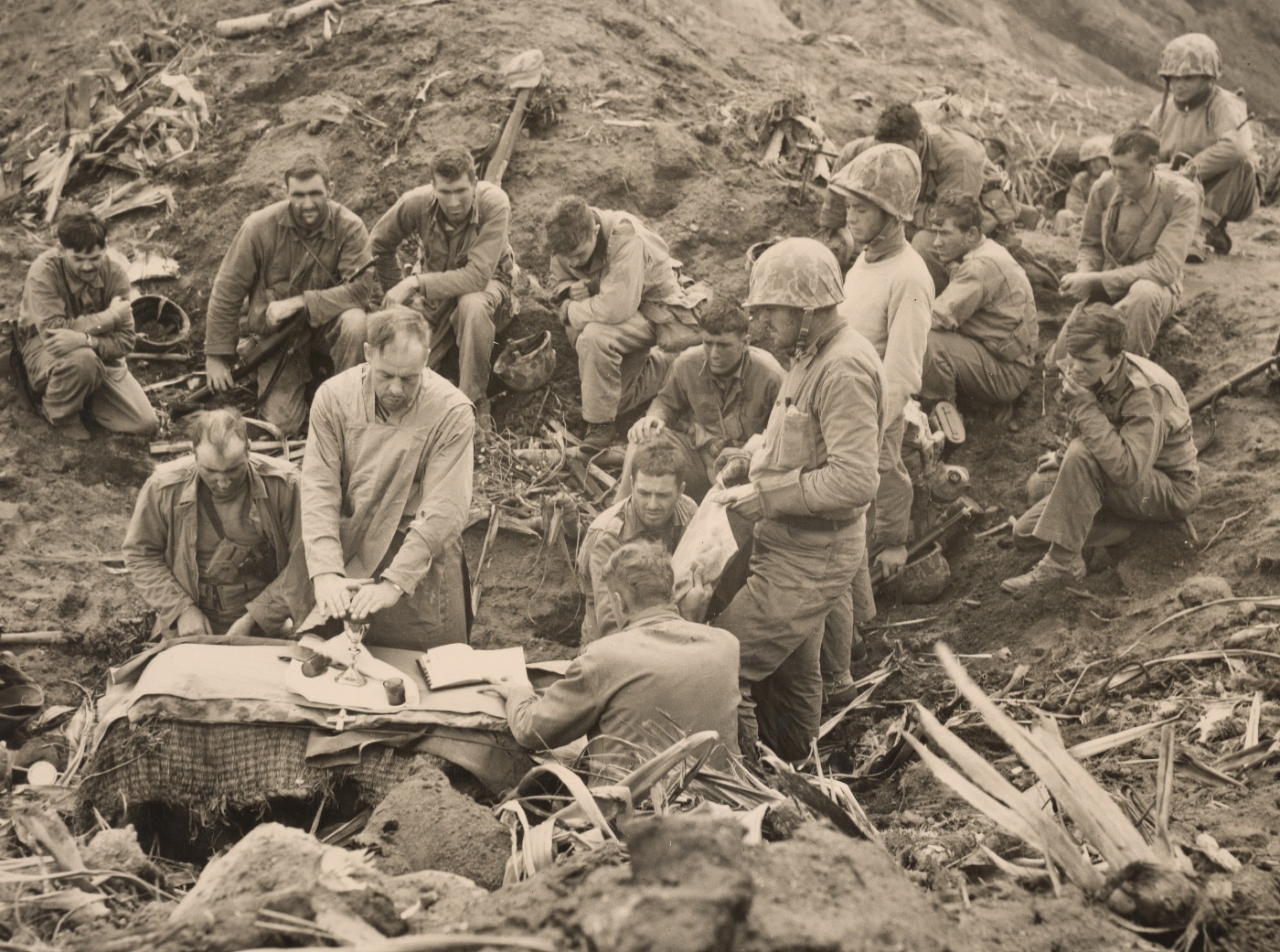
Catholic Mass is celebrated on Iwo Jima. Two Marines wearing helmets shield the improvised altar from high winds that rake the volcano summit. Image: Sgt. Lou R. Burmeister/U.S. Marine Corps
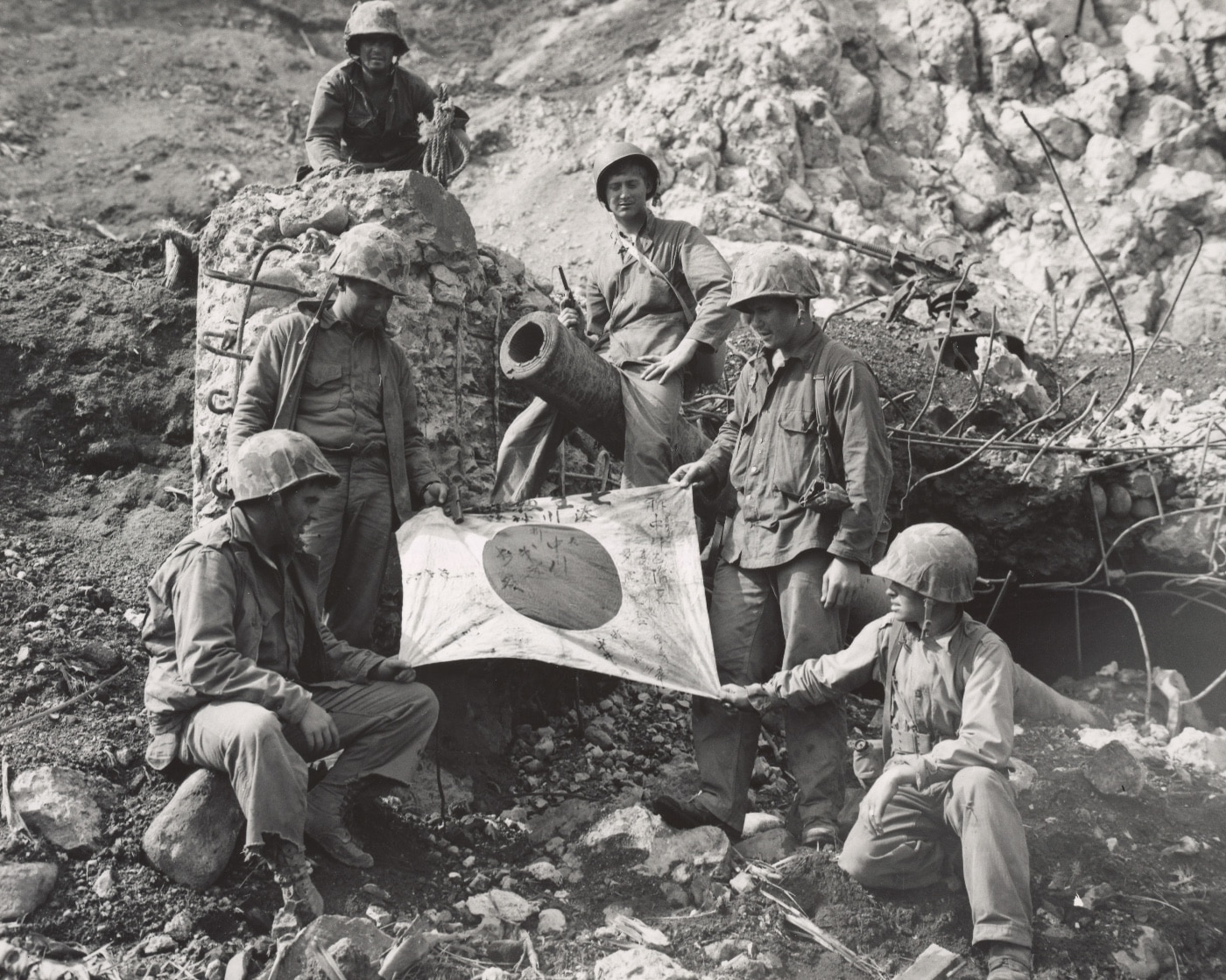
Marines of the 5th Marine Division with a captured Japanese flag on Iwo Jima. Image: Staff Sgt. M.A. Cornelius/U.S. Marine Corps
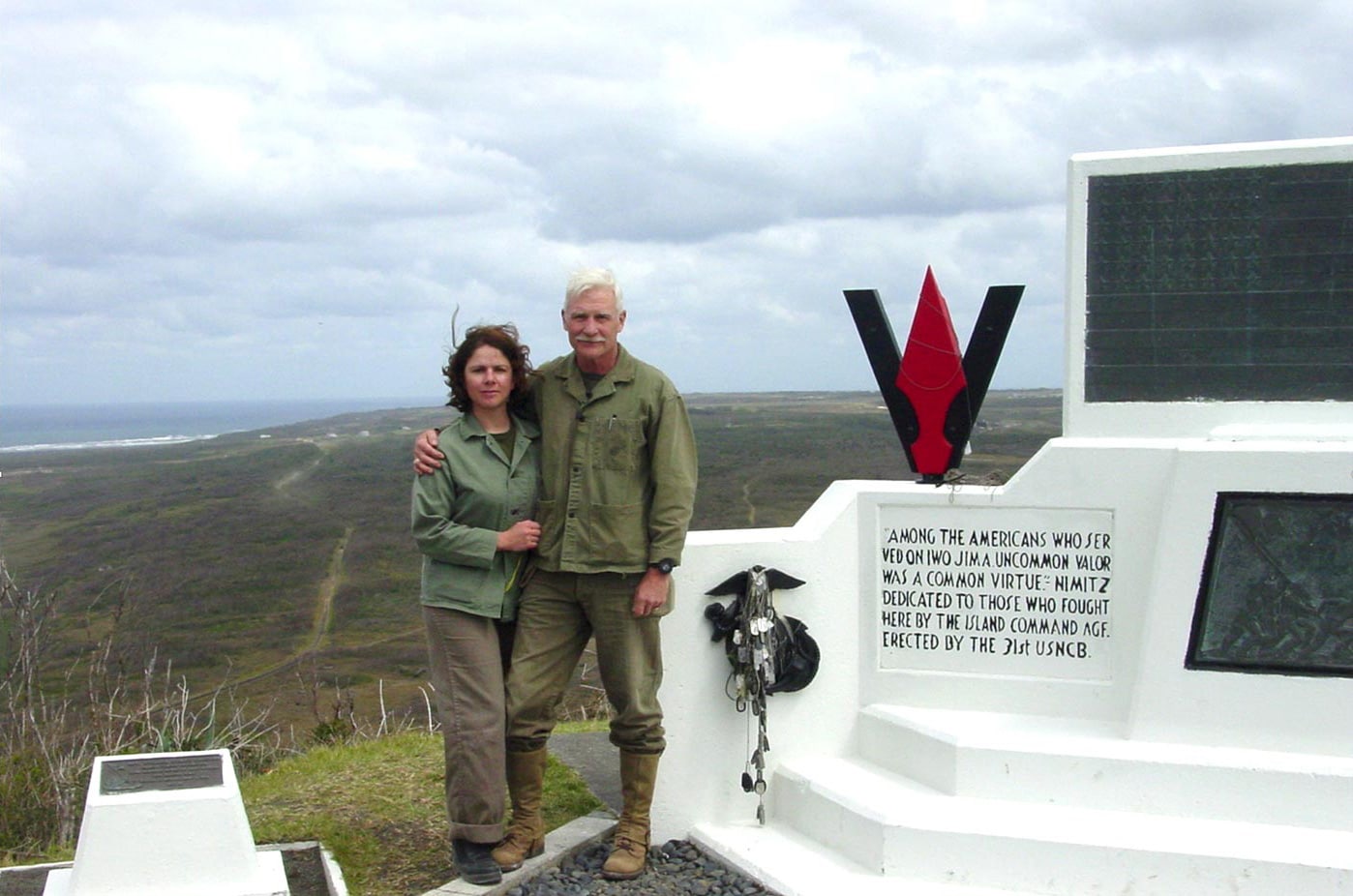
The author with his wife Julia at the 5th Marine Division monument on Iwo Jima. Image: Dale A. Dye




